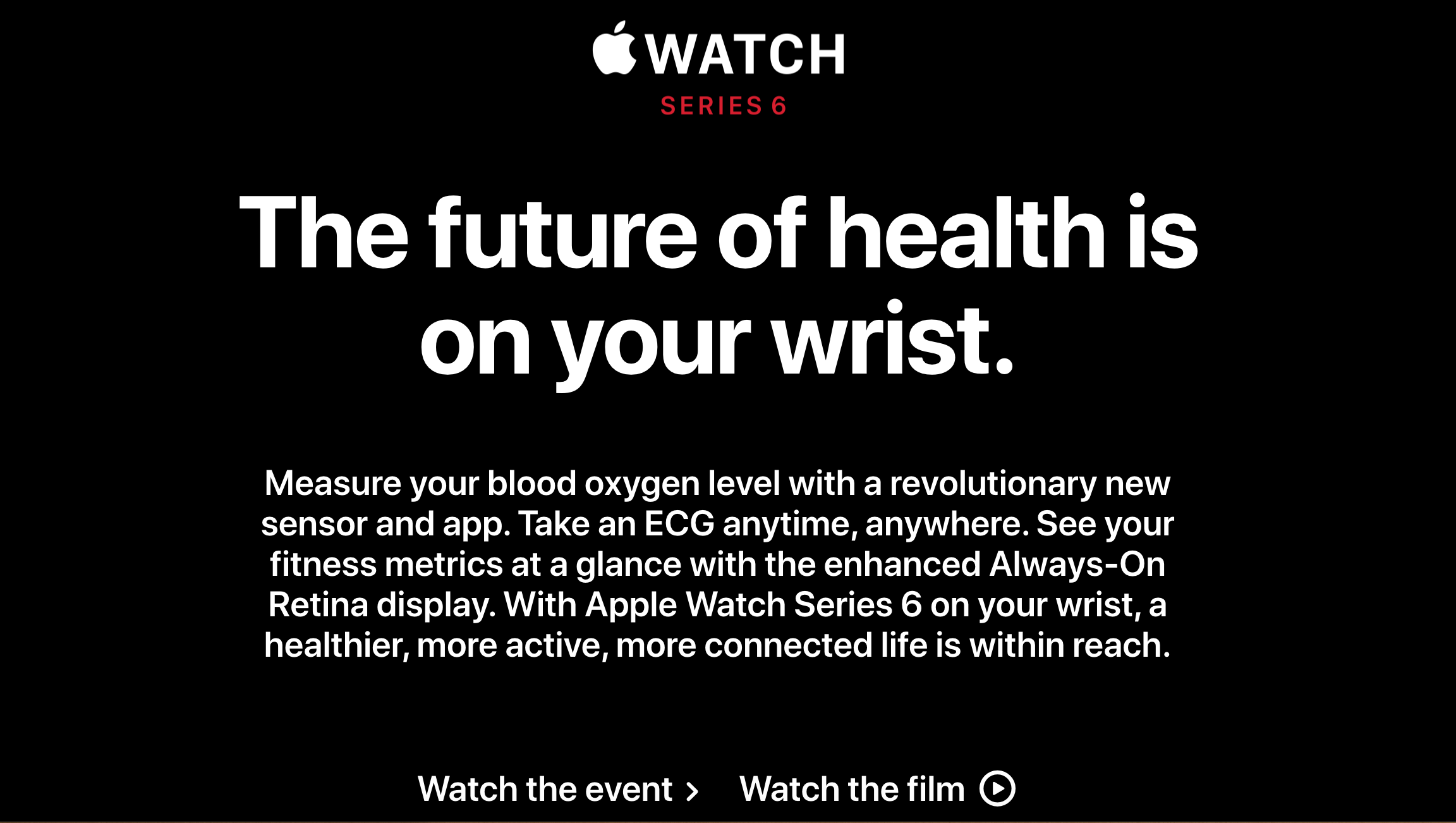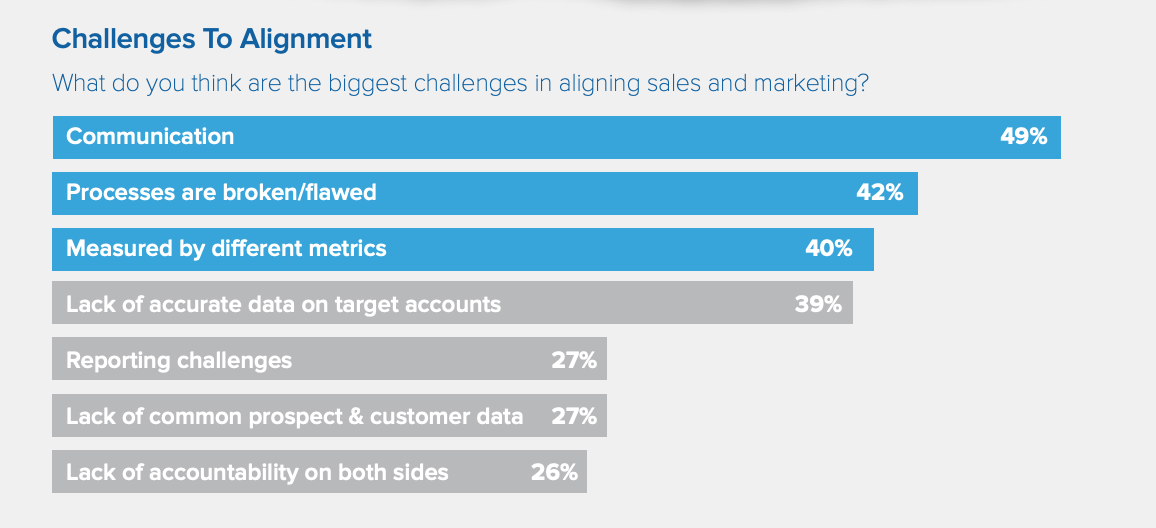This is the content.php article
Month: March 2021
This is the content.php article
Whether you’re launching a new product in the market or building a new business from scratch, there are a few common marketing myths we wanted to clear up before you venture out on your next campaign.
Myth 1 – You should focus more on the features of your product than its benefits
Reality: Customers want businesses to answer the magical question of “What’s in it for me?”
They want specifics about how the features (or what the product does) make their lives easier and gives them a tangible benefit. Vague promises of “increasing sales” or “saving time” won’t work for customers.
But one company known for showing the benefits of their products, and doing it well, is Apple.

With the release of their most recent Apple Watch Series 6, the brand uses a catchy headline to quickly grab the reader’s attention, which is immediately followed up with a rundown of its features:
– Measures blood oxygen levels with a new sensor and app
– A portable electrocardiogram (ECG)
– Constant monitor fitness stats
– Enhanced Retina display
Then they reiterate how this device gives the wearer a powerful, convenient tool to live a healthier life.

Each section of the Apple Watch landing page pairs a sexy product image with an in-depth description highlighting the benefits of the device.
They have a clear understanding of their customer’s demands. These people want to embark on a health journey aided by technology, and Apple is the brand to facilitate it.
Myth 2 – A/B testing should only start at the beginning of a marketing campaign
Reality: Depending on the KPI’s you’ve established to measure your campaign against, you’ll need to conduct A/B testing throughout its entirety.
Like every experiment, you’ll need to keep testing and evaluating the results. If you’ve never run a marketing campaign before, here are some metrics to consider measuring.
– Website traffic
– Call-to-Action (CTA) conversion rate
– Landing page bounce rate
– Cart abandonment rate
– Cost of customer acquisition (COCA)
– Social media engagement/reach
– Email open rate
A/B testing can become extremely granular, and with digital marketing, details matter.
Depending on your business goals, these metrics can reveal how successful a campaign is. They’ll also let you know if there’s a need for new or different products based on performance and customer feedback.
Myth 3 – Marketing insights should solely dictate your design strategy
Reality: Marketing and sales teams need to work in tandem to ensure the customer receives a consistent message.
If the design of an email campaign or landing page is solely dictated by marketing, they’re missing out on the sales team’s valuable insights. Their data and perspective could help yield a better campaign, which would move the company closer to its strategic goals.

According to the Demand Gen Report, the biggest schism between sales and marketing teams is caused by a lack of communication. Somewhere the wires are getting crossed, and everyone is not on the same page, resulting in launching campaigns without all of the information needed to make it a success.
When both sides work together to inform the design and content of a campaign launch, it leads to:
– Getting better, qualified leads
– Receiving more accurate customer data
– Improved feedback and communication about campaigns
If one hand doesn’t know what the other is doing, it’s difficult for creative teams to produce effective copy and designs.
Myth 4 – Products from smaller brands have no chance of beating the “big guys”
Reality: Ingenuity and creativity can take a small company from unknown to famous in a very short time.
Long ago, in 2012, the Dollar Shave Club was a personal hygiene company providing men’s razors as part of a subscription service. They were a scrappy brand without a huge budget or dedicated fan base.
And the competition? They were going up against Gillette, a $50 billion behemoth, who was the reigning champ in this space.
As the underdog in this fight, Dollar Shave Club capitalized on a segment the competition wasn’t serving—budget-conscious customers. These people wanted quality blades at a low price.
In a direct-response video posted on YouTube, Dollar Shave Club proclaimed, “Our blades are f***ing great!” and used humor to show the superiority of their razors.
Within 48 hours after the video’s release, Dollar Shave Club’s website was so overrun with visitors that it crashed. After getting back up and running, they added over 12,000 new subscribers to their service within a few days of the video appearing on YouTube.
It shows that launching a product doesn’t mean that your business needs to have a huge team and budget behind it. Actually, it might work out better to stay small.
In the end, Dollar Shave Club was acquired by Unilever, but they still live on as a fun, relatable brand that bucked marketing norms and took advantage of social media to expand their reach.
Myth 5 – You should only focus on the marketing tactics
Reality: Before producing any campaign content, you have to create a marketing strategy that satisfies customers’ needs and wants.
It’s not entirely uncommon for businesses to focus on designing emails, writing blog posts, and creating other content without really considering the person on the other side of the screen.
They aren’t asking the big questions about their audience, such as:
What are they looking for?
And how can the company align its products with their expectations?
Yes, it’s important to produce marketing materials that capture people’s attention, but keeping it, and more importantly, making them come back for more, is a bigger challenge.
This is why you need a solid plan that guides the tactics. Not the other way around.
To do this, think about how they use products, find information, or interact with any other marketing touchpoint. Once you have a clear understanding of the customer’s mind, you can work backward from there.
Myth-busted
While the tools marketers use change on an almost daily basis, the rules haven’t. The customer’s needs always come first, and your marketing initiatives should center around answering their burning question of “What’s in it for me?”
This is the content.php article
This is the content.php article
This is the content.php article
Have you ever had your account hacked by a leaked password? It’s not a fun experience, doing triage and panicking about getting back into your digital accounts. Agency Åkestam Holst has a clever and very cheeky design campaign for a Swedish cybersecurity firm to shame users into toughening up their passwords. The racy words get your attention, and the company smartly educates viewers about common passwords that are easily guessed, and therefore allow access to your supposedly-secure digital vaults.
This is the content.php article
What can you learn from the other team that will inform your own social media marketing?
Well, they can teach you about trends you may not have yet picked up on. They can also reveal what’s happening in their own business.
You’ll want to pay attention to not only what they’re doing, but what they’re saying on social media.
Here’s what else your competition can show you.
How Your Brand Hold Up Against Theirs
It’s common practice to creep on a competitor’s social profiles. You or your marketing team can get a sense of how well your overall presence stacks up when comparing their efforts against your own.
And while you don’t want to ever copy them, you do want to see if there are any gaps in their offerings or messaging that you can capitalize on.
Such as:
Unique Product Offerings
Did they release a new product?
Maybe there’s a way you can swoop in and create something better once you do a little social listening to see what people are saying about it. These conversations could even inspire a few ideas for future product releases.
Conversations and Trends
What kind of discussions are people having on your competitor’s pages?
If they’ve got an active audience, you can learn about their motivators and whether or not the brand is truly engaged in creating a dialogue with them. Use those insights to deliver more meaningful content on your social profiles.
Checking Out Their Content’s Performance
Obviously, you won’t have access to the nitty-gritty details from their social profile, unless you invest in one of the tools we’ll get to later. But you can take a peek at the number of ‘likes’ and comments for different posts.
Once you do, compare it to the content you’re putting out there. Are you getting the same level of engagement? If not, you could explore posting different types of media like videos and audio clips to increase page activity.
Ways to Give Your Audience Better Content
And speaking of posting different types of content, your competitors can give you ideas about how to kick yours up a few notches.
People on social media are a goldmine for gathering data about their feelings towards products and services. If some questions or comments keep coming up, you could start producing quick videos or even mini podcasts to address them.
It’s also an opportunity to go in-depth with the topic and show without a hard sell how your offerings are superior.
How They’re Talking About Your Brand
Wondering if people are talking smack or praising your brand on social media? Competitive analysis tools like Sprout Social, Brandwatch, and Socialbakers give companies a full, in-depth look at the social conversations happening online.
The insights and metrics revealed through these tools will help you make smarter decisions about the content your company posts.
Insight into Their Social Media Marketing Strategies
Now that you know what they’re saying and have some valuable data at hand, the pieces of the puzzle begin to fall into place. You’re getting a glimpse into your competition’s social media marketing strategy.
You’ll see where your company’s marketing is coming up short and about the different campaigns they’re rolling out and how well they did.
And this information can be crucial in helping you to tweak and come up with ideas that can help you create influential, potentially viral, campaigns.
What’s Next?
So, where does this leave your social media marketing efforts? Well, hopefully, in a better place. Learn from your competitors and let the conversations happening online push you to create more effective social media marketing campaigns that ultimately increase your bottom line.


